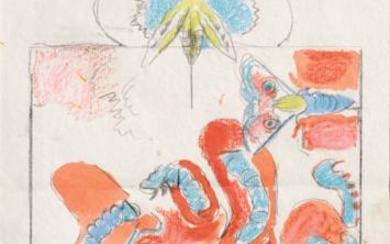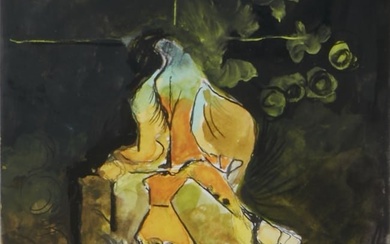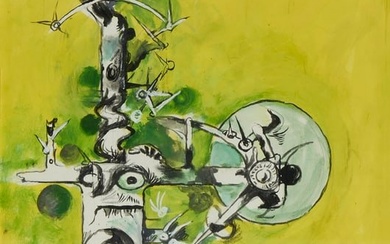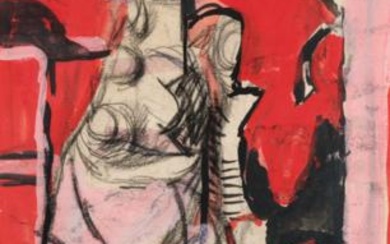GRAHAM SUTHERLAND, O.M. (BRITISH, 1903-1980)
GRAHAM SUTHERLAND, O.M. (BRITISH, 1903-1980)
Feeding a Steel Furnace, Swansea
gouache, pastel, charcoal, pen and ink
20.8 x 17.4 cm. (8 1/8 x 6 7/8 in.)
Executed in 1942
Provenance
Private Collection, Italy
With Crane Kalman Gallery, London, March 2017, where acquired by the present owner
Exhibited
London, Imperial War Museum, Sutherland, The War Drawings, 1982, cat.no.108 (ill.b&w)
Penzance, Penlee House and Museum, From Darkness into Light: Graham Sutherland; Mining, Metal and Machines, 14 September-23 November 2013; this exhibition travelled to Swansea, National Waterfront Museum, 7 December 2013-23 March 2014
Literature
Roberto Tassi, Graham Sutherland, The War Time Drawings, Sotheby's Parke Bernet Publishing, London, 1979, cat.no.115 (ill.b&w)
Paul Gough, Sally Moss and Tehmina Goskar, From Darkness into Light: Graham Sutherland; Mining, Metal and Machines, Sansom & Company, Bristol, 2013, p.61 (col.ill.)
ARR
British photographer Cecil Beaton's assessment of Sutherland’s painting remarked on the artist’s ‘opportunity to capture this fleeting phenomenon of sequined brilliance, of mystery, of glowing magic'.
The present work is almost certainly a study for Feeding a Steel Furnace 1941-42, which residues in the Tate Collection and was presented by the War Artists Advisory Committee in 1946.
This particular gouache is microcosmic in capturing Sutherland's contribution to art during the war. The gouache is characteristically the medium he most often used and many examples can be found from the same period. Feeding a Steel Furnace, Swansea is as much about Sutherland's experience of a steel furnace as it is an account of the art making process. Line and colour capture the heat of the burning furnace, paradoxically its powerful blaze and temperamental characteristics.
This work importantly sits alongside many other notable works which establishes Graham Sutherland, as not only a man of tremendous talent, who went onto teach at serval top institutions including the Chelsea School of Art and Goldsmiths Collage, but further locates him alongside a milieu of sentimental British artists who went onto to occupy the narrative of artworks produced during this period. His famous contribution to destroyed Coventry Cathedral, comprised many studies later amalgamating to the large and widely known Christ in the Glory in the Tetramorph, tapestry, yet another example of the artist’s sentimental importance.
Sale price
Estimate
Reserve
Time, Location
Auction House
GRAHAM SUTHERLAND, O.M. (BRITISH, 1903-1980)
Feeding a Steel Furnace, Swansea
gouache, pastel, charcoal, pen and ink
20.8 x 17.4 cm. (8 1/8 x 6 7/8 in.)
Executed in 1942
Provenance
Private Collection, Italy
With Crane Kalman Gallery, London, March 2017, where acquired by the present owner
Exhibited
London, Imperial War Museum, Sutherland, The War Drawings, 1982, cat.no.108 (ill.b&w)
Penzance, Penlee House and Museum, From Darkness into Light: Graham Sutherland; Mining, Metal and Machines, 14 September-23 November 2013; this exhibition travelled to Swansea, National Waterfront Museum, 7 December 2013-23 March 2014
Literature
Roberto Tassi, Graham Sutherland, The War Time Drawings, Sotheby's Parke Bernet Publishing, London, 1979, cat.no.115 (ill.b&w)
Paul Gough, Sally Moss and Tehmina Goskar, From Darkness into Light: Graham Sutherland; Mining, Metal and Machines, Sansom & Company, Bristol, 2013, p.61 (col.ill.)
ARR
British photographer Cecil Beaton's assessment of Sutherland’s painting remarked on the artist’s ‘opportunity to capture this fleeting phenomenon of sequined brilliance, of mystery, of glowing magic'.
The present work is almost certainly a study for Feeding a Steel Furnace 1941-42, which residues in the Tate Collection and was presented by the War Artists Advisory Committee in 1946.
This particular gouache is microcosmic in capturing Sutherland's contribution to art during the war. The gouache is characteristically the medium he most often used and many examples can be found from the same period. Feeding a Steel Furnace, Swansea is as much about Sutherland's experience of a steel furnace as it is an account of the art making process. Line and colour capture the heat of the burning furnace, paradoxically its powerful blaze and temperamental characteristics.
This work importantly sits alongside many other notable works which establishes Graham Sutherland, as not only a man of tremendous talent, who went onto teach at serval top institutions including the Chelsea School of Art and Goldsmiths Collage, but further locates him alongside a milieu of sentimental British artists who went onto to occupy the narrative of artworks produced during this period. His famous contribution to destroyed Coventry Cathedral, comprised many studies later amalgamating to the large and widely known Christ in the Glory in the Tetramorph, tapestry, yet another example of the artist’s sentimental importance.







